Top pre-First World War brass era cars including a Mercer, Simplex, Lozier, and Underslung are on offer at the Gooding Pebble Beach 2023 sale during Monterey week.
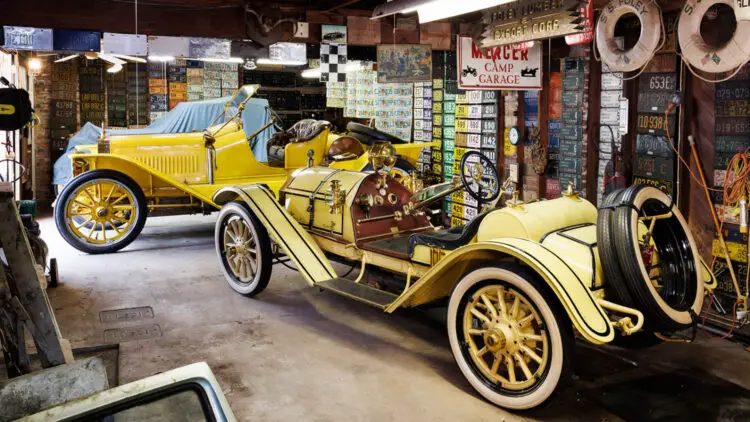
Four American brass-era cars are expected to achieve over a million dollar each at the Gooding Pebble Beach classic car auction during Monterey car week 2023. The 1912 Simplex 50 HP Toy Tonneau (Estimate: $3,000,000 – $4,000,000) is sold from single-family ownership. The 1914 Mercer Type 35-J Raceabout (Estimate: $3,000,000 – $4,000,000) and 1913 Lozier Type 72 Meadowbrook Runabout (Estimate: $1,000,000 – $1,500,000) are sold from the estate of the well-known collector Jerry S. Foley III. The 1913 American Underslung Type 56-A Traveler (Estimate: $800,000 – $1,200,000) is the sole example known to have survived.
Gooding Pebble Beach Sale 2023
Gooding & Company Pebble Beach classic car auction 2023: 18 and 19 August 2023 at the Pebble Beach Parc du Concours during the annual Monterey Motoring Week in California, USA.
Previous Gooding Pebble Beach sale results during Monterey Week:
| Year | Earnings ($ million) | Million-Dollar Cars | Lots Sold & Sell-Through Rate |
| 2023 | $95 | 24 | 133 sold, average price $714,522 |
| 2022 | $109 | 28 | 135 of 158, 85%, average price of $810,758 |
| 2021 | $107 | 24 | 115 of 132, 87%, average price of $930,829 |
| 2020 | – | 5 | 55 of 77, 71% (online-only auction) |
| 2019 | $76.8 | 17 | 108 of 140, 77% |
| 2018 | $116.5 | 25 | 123 of 147, 84%, average price of $947,174 |
| 2017 | $91.5 | 22 | 110 of 135, 81%, average price of $832,670 |
| 2016 | $129.8 | 26 | 115 of 138, 835, average price of $1,128,606 |
The Pebble Beach auction record is $22,000,000 paid for the 1935 Duesenberg SSJ in 2018. It is the most expensive car ever sold by Gooding, the most expensive American car ever, the most expensive pre-war car ever, and of course the Duesenberg marque record holder.
Top Brass Era Cars at Gooding Pebble Beach 2023
The following pre-First World War brass era automobiles are expected to sell for over a million dollar at the Gooding Pebble Beach classic car auction 2023:
| Year | Car | Estimate | |
| 1 | 1914 | Mercer Type 35-J Raceabout | 3,000,000 – 4,000,000 |
| 2 | 1912 | Simplex 50 HP Toy-Tonneau | 3,000,000 – 4,000,000 |
| 3 | 1913 | Lozier Type 72 Meadowbrook Runabout | 1,000,000 – 1,500,000 |
| 4 | 1913 | American Underslung Type 56-A Traveler | 800,000 – 1,200,000 |
Multimillion-Dollar Brass Era Automobiles at Gooding Pebble Beach 2023
1912 Simplex 50 HP Toy Tonneau
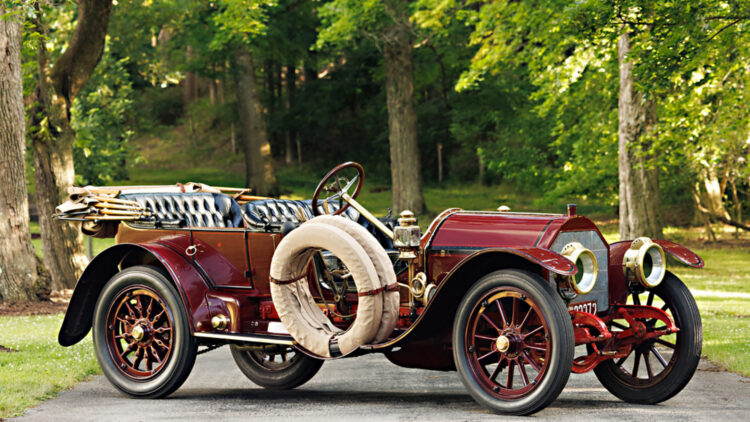
In the collector car world, few words are as enticing as “single-family ownership.” When this refers to a car that has never come to market in over 111 years, offered with impeccable documentation from new, the response is incomparable. Such is the case with the 1912 Simplex 50 HP Toy Tonneau (Estimate: $3,000,000 – $4,000,000) on offer at Gooding Pebble Beach 2023 Auctions. This SImplex was originally purchased new for the consignor’s great-grandfather, William Penn Snyder Jr., when he was just 24 years old.
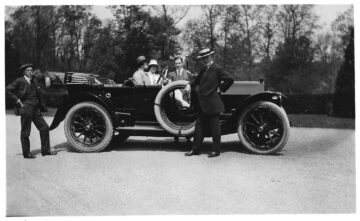
At the time, Simplex was one of the greatest American automotive manufacturers, catering to a clientele of the most prominent East Coast families. First named S&M Simplex after its builders, the New York City automotive import firm Smith & Mabley, Simplex Automobile Company was established after wealthy textile importer Herman Broesel purchased S&M in 1907. The Simplex Automobile Company unveiled a new 50 HP model, one of the finest cars of its era capable of reaching speeds in excess of 80 mph. Each Simplex was built on a robust Krupp steel chassis, featuring a powerful T-head chain-drive engine and mounted with custom coachwork from a host of respected manufacturers: Brewster, Healey, Demarest, Holbrook, or Quinby, as with the Simplex on offer here.
This Simplex, chassis no. 799, has been integral to the Sndyer family legacy since February 1912, when William Penn Snyder Sr. purchased it initially as a two-passenger Runabout, or “Speed Car,” for his son as a college graduation gift. The influential family ran one of the largest integrated steel companies in Pittsburgh and played a pivotal role in the development of the state of Pennsylvania for several centuries. In the early 20th century, the Snyder family owned an impressive stable of cars, including over three Simplexes. Original documentation on file from the Simplex factory to Mr. Snyder notes that this chassis was an “extra fast one,” and this proved to be true, as the Speed Car got into an accident in its first year of ownership.
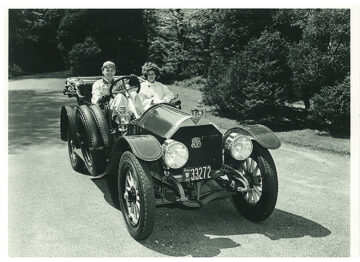
Deeming the lightweight Runabout too fast for his son, William P. Snyder Sr. decided to have the chassis tastefully rebodied by Quinby as a four-passenger Toy Tonneau in December 1912. As fate would have it, the allure of the Simplex automobile would even lead William Penn Snyder Jr. to his wife: Mr. Snyder met Marie Elise Whitney on the Long Island Ferry, where she was driving her own 1909 50 HP Chain-Drive Simplex. Once the ferry docked, the two raced each other in their respective Simplexes. Marie Elise won! The two married in February 1917, and the new Mr. and Mrs. Snyder brought this 1912 Simplex along on their honeymoon.
Since then, this Simplex has been meticulously maintained and exercised, and has always lived on the family property in Pennsylvania at Wilpen Hall, a family estate enjoyed by many generations of the Snyder family for more than a century. It was sympathetically restored in the 1950s, and throughout the years, has participated in many Glidden and Friends of Ancient Road Transportation tours. More recently, it placed 2nd in Class at the 2013 Pebble Beach Concours d’Elegance® Simplex event, and also earned the Briggs Cunningham Award for the day.
Brass Era Cars from the Jerry S. Foley III Estate
The two most expensive pre-First World War brass era cars on offer at the Gooding Pebble Beach 2023 classic car sale are the 1914 Mercer Type 35-J Raceabout and a 1913 Lozier Type 72 Meadowbrook Runabout from the Jerry S. Foley III Estate.
Mr. Foley, a lifelong resident of Jacksonville, Florida, was a passionate collector of vintage automobiles, and throughout his lifetime, amassed an extraordinary collection. He was regularly active in the community, frequenting concours and events all around the US where his cars won countless awards. He and his late wife, Carolyn Foley, traveled the country on many vintage car tours and rallies, as he was a member of numerous vintage car clubs throughout the years. Since 1957, Mr. Foley served as the Director of the Florida Region Antique Automobile Club of America and even initiated the creation of the Florida Horseless Carriage License Plate.
1914 Mercer Type 35-J Raceabout
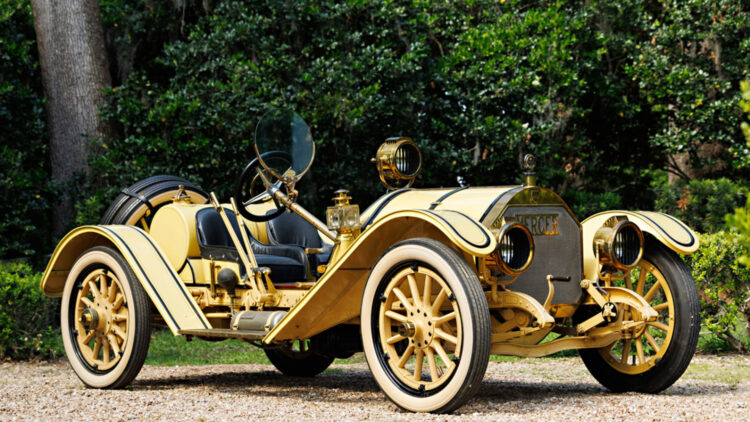
The 1914 Mercer Type 35-J Raceabout (Estimate: $3,000,000 – $4,000,000), chassis 1967, is one of just four known 1914 Raceabouts to survive today. It features a highly desirable and rare four-speed gearbox, as opposed to the three-speed gearbox cars produced for 1911-1912. It is powered by a four-cylinder T-head engine that produces 60 hp at 1,900 rpm, and its low-slung chassis is laid out in right-hand drive. It is appropriately finished in a bright Canary Yellow with black striping and black leather upholstery.
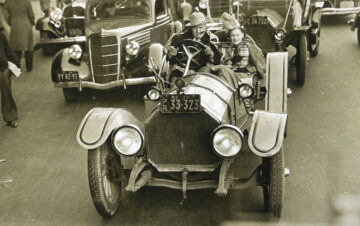
In its early life, 1967 was owned by Socony Oil, the predecessor to today’s Mobil petroleum company. In 1935, it was driven by Mercer team driver Barney Oldfield, and shortly thereafter used in the match race for early racing cars at the start of the 1936 Vanderbilt Cup, where it was driven by another Mercer team ace, Ralph DePalma.
This exceptionally rare Raceabout was eventually purchased by legendary opera singer James Melton, becoming the centerpiece of his world-famous collection. Melton was one of the first celebrity car collectors, and wrote many books on automobiles, in addition to housing his most cherished pieces in a museum. After Melton’s death, the Raceabout eventually made its way to Jerry Foley’s collection, where it remained for over 50 years.
America’s first true sports car, the Mercer Raceabout was the brainchild of talented designer and chief engineer Finley Robertson Porter and industrial manufacturers, the Roebling and Kuser families of Brooklyn Bridge construction fame. With the introduction of the T-head Raceabout, which was introduced in late 1910 for the 1911 model year, Mercer took the American racing world by storm, utterly dominating the scene for the next five years. Boasting a top speed between 70 to 80 mph, the Raceabout was incredibly fast for its time and started off by clocking victories at the Panama-Pacific Light Car Race in San Francisco with Charles Bigelow at the wheel, followed by the Savannah Challenge Trophy in 1911.
In 1914, Mercer became the first American-made automobile to win the American Grand Prix. The Raceabout was the car of choice for the best drivers of its day and was driven by Ralph DePalma, Spencer Wishart, Eddie Pullen, Hugh “Hughie” Hughes, and the great Barney Oldfield. With an impressive power-to-weight ratio, thoughtfully selected gear ratios, and agile handling, the Raceabout proved successful both on the road and the track. Its minimalistic, purposeful design incorporated two bucket seats and a monocle windshield, leaving the driver, cockpit, and everything in between exposed to the elements – resulting in a fully visceral driving experience like no other.
1913 Lozier Type 72 Meadowbrook Runabout
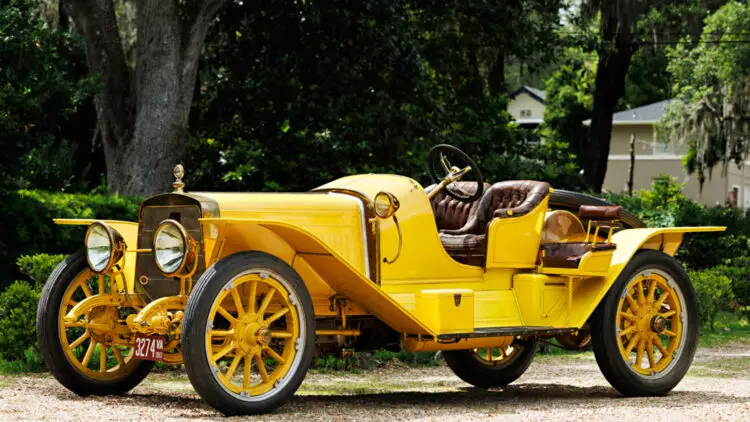
The 1913 Lozier Type 72 Meadowbrook Runabout (Estimate: $1,000,000 – $1,500,000) is a historic example of one of the rarest and most sought-after early American automobiles. The sporty-looking two-seater features a luxuriously appointed and comfortable driver’s seat and emphasizes a performance-oriented feel. This highly authentic sporting car boasts a rich history of rally and show accolades throughout its life. Last offered for sale in 1959, when it joined the collection of Jerry Foley, the Lozier encapsulates the history and legacy of an iconic, albeit short-lived, American manufacturing legend.
In the early 1880s, Henry Abram Lozier founded the Lozier Manufacturing Company, heavily investing in the production and manufacture of the Cleveland bicycle. Lozier would go on to sell the company for an incredible fortune of $4 million, which would allow him and his son, Harry, to make the foray into the world of motoring. In the early 1900s, Harry Lozier turned his attention to the internal combustion engine. The Lozier Motor Company was founded, with its headquarters located in Plattsburgh, New York. The company initially produced marine engines, but in 1905, redirected its focus to high-end motor cars. Within a few short years, Lozier had relocated its headquarters to the heart of New York City, employing several hundred people in its pursuit to make one of the finest automobiles of its time.
Lozier automobiles featured exceptional engineering and machinery, inspired by Europe’s finest cars of the period. The vehicles were engineered by John G. Perrin, who drew inspiration from the brilliant mechanics of German marques and the sophisticated styling of French automakers. Loziers featured an unprecedented stamina, proving strong and enduring – differentiating them from most all other cars of the time.
1913 American Underslung Type 56-A Traveler
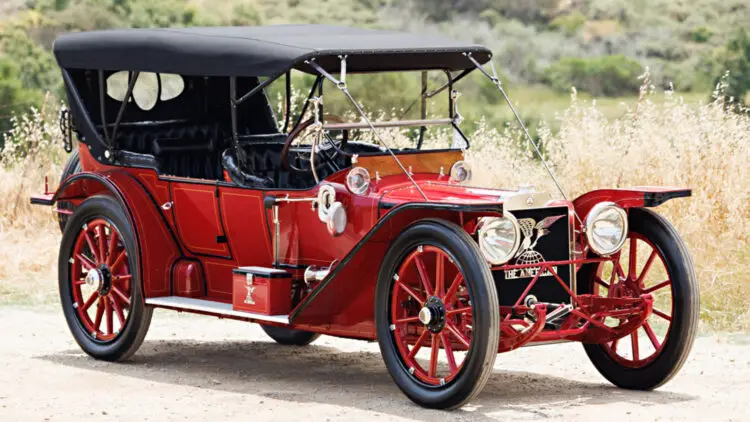
The 1913 American Underslung Type 56-A Traveler (Estimate: $800,000 – $1,200,000) is the sole example known to survive, with a rich, well-documented provenance tracing back to its original owner. Delivered new to Courtney Willits of New Boston, Illinois, it remained in his ownership until his passing in 1945. It was then purchased by D. Cameron Peck, heir to the Bowman Dairy fortune, who outbid celebrated opera tenor James Melton for the car. Mr. Peck then sold the Underslung to Frank Miller of Ohio, who commissioned noted restorer Ralph Buckley to paint it Orleans Blue ahead of its participation in the 1948 Glidden Tour. The car joined the collection of Philip Peterson of Worcester, Massachusetts in 1974 before being acquired by the current owner, a knowledgeable and passionate Southern California collector.
The consignor entered the Traveler in a number of Brass Era rallies, including the famous Modoc Tour, prior to embarking on an exacting restoration in the late 1980s. This multiyear process was initiated by former director and general manager of Harrah’s Automobile Collection, Clyde Wade, and completed by noted antiques restorer, Scott Andrews. Faithfully presented in its original color scheme of American Red with black accents, this Traveler has been selectively displayed since its restoration, including at the Ironstone Concours d’Elegance and the 2010 Pebble Beach Concours d’Elegance®, where it received the Charles A. Chayne Trophy. It has also been loaned to the National Automobile Museum in Reno, Nevada, for continued display.
Few Brass Era cars are as imposing and attractive as the American Underslung. Produced by the American Motor Car Company of Indianapolis, the Underslung is the brainchild of designer Fred Tone, featuring a sleek, racy profile due to its front and rear axle placement above the frame rails. Its low-slung body is carried by an exceptionally large set of wheels, with its low center of gravity resulting in superior handling and a strikingly aggressive silhouette. The Type 56 was the largest and most dramatic of all the Underslungs, with an especially long wheelbase, full rear door, jump seats, and the largest wheels ever fitted on the model at 41″. For the 1913 model year, the Traveler was updated to the Type 56-A, featuring new electric headlights and redesigned inset cowl lights to include ventilation inlets.
Monterey Week 2023 Classic Car Auctions
Top classic car auctioneers with sales during Monterey Week 2023 include Gooding (Pebble Beach), Bonhams (Quail Lodge), RM Sotheby’s, Broad Arrow, and Mecum.
Monterey Week 2023 Auction Results
- Top Ten Monterey Week Auction Results
- Bonhams: Quail Lodge Sale Results, 1967 Ferrari 412P
- Gooding: Pebble Beach Sale Results
- Mecum: Monterey Sale Results
- RM Sotheby’s: Monterey Sale Results, Lost & Found Ferrari Results
Monterey Week 2023 Auction Previews
Monterey Week 2023 Pre-Auction Announcements
- Bonhams: 1967 Ferrari 412P Berlinetta
- Gooding: 1933 Bugatti Type 55 Roadster
- Gooding: Top Ten Ferraris (including a 250 GT SWB Berlinetta)
- Gooding: Top American Brass-Era Cars (including a Simplex and Mercer)
- RM Sotheby’s: Top Ten Ferraris (including a 250 LM and California Spider)
- RM Sotheby’s: The Lost and Found Collection of 20 Ferraris
- RM Sotheby’s: Steve McQeen’s 1967 Ferrari 275 GTB/4
- RM Sotheby’s: 1938 BMW 328 ‘Special Competition’ Roadster
Previous Monterey Week Auction Results